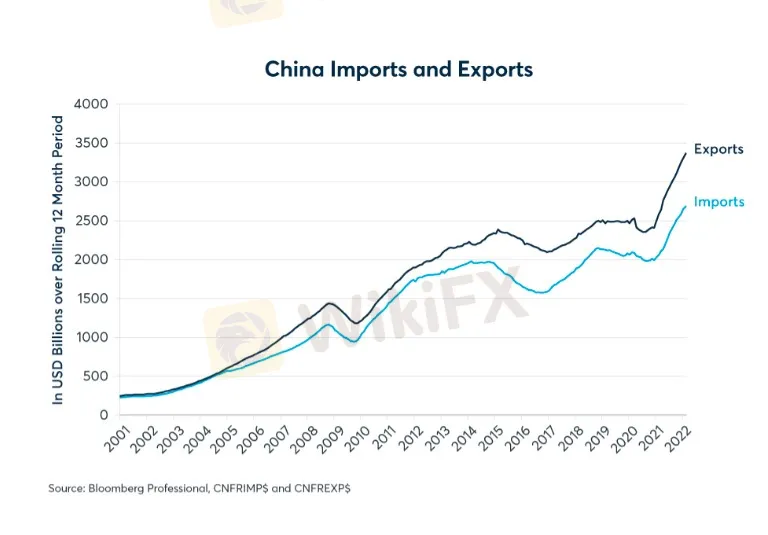简体中文
繁體中文
English
Pусский
日本語
ภาษาไทย
Tiếng Việt
Bahasa Indonesia
Español
हिन्दी
Filippiiniläinen
Français
Deutsch
Português
Türkçe
한국어
العربية
Why is China's Yuan Climbing?
Abstract:Yuan has strengthened against USD over past 15 months
Chinese high-yield bond prices have tumbled since 2021
Rising cost of credit could lead to a weaker yuan
On one side of the Pacific coast, expectations have shifted to a dramatically tighter monetary policy in U.S. On the other, the Peoples Bank of China (PBoC) continues to ease monetary policy. This might have set off expectations for the U.S. dollar to rise sharply versus the onshore and offshore Chinese yuan (CNY and CNH). But CNHUSD has strengthened slightly over the past 15 months (Figure 1).
Figure 1: Up until 2020, CNHUSD usually tracked the PBoCs monetary policy

So why has the Chinese currency, which normally strengthens when the PBoC raises rates and falls when it eases, decoupled from monetary policy? The answer appears to lie in the strength of Chinas exports. Since the beginning of the pandemic, Chinese exports have risen more quickly than imports, and the resultant growth in the trade surplus appears to have supported CNH (Figure 2).
Figure 2: As demand for manufactured goods rose during the pandemic, Chinas exports surged

The strength of Chinese exports reflects, in part, a shift in global consumption patterns during the pandemic. Less able to spend money on experiences like restaurant meals, sporting events, movies, and travel, consumers shifted spending towards manufactured goods. In the U.S., for example, consumer spending on goods rose by 22% between December 2019 and December 2021, while spending on services rose by only 6% during the same period. China, being the worlds premier exporter of manufactured goods, benefitted disproportionately from this shift in spending.
Going forward, however, the Chinese trade picture might not continue to be as supportive for the yuan. On the one hand, consumer spending appears likely to shift back towards experiences as most of the world cautiously reopens for business. On the other hand, China‘s cost of imports might rise significantly in line with higher prices for agricultural goods, metals and energy following Russia’s invasion of Ukraine.
Up to now a widening trade surplus has helped to support China‘s currency by counteracting a relative easing of Chinese monetary policy with respect to the U.S. and other currencies where central banks have begun tightening policy. Going forward, there appears to be a growing risk that a diminishing trade surplus could begin pulling China’s currency in the same downward direction as monetary policy.
Compounding this concern is the state of China‘s domestic economy. Over the past dozen years China’s debt levels have doubled relative to the size of its economy. Since 2008, China‘s non-financial corporate debt rose from 96% to 156% of GDP, while household debt expanded from 18% to 62% of GDP, and government debt more than doubled from 28% to 68% of GDP. Overall, China’s total debt burden has risen from 141% to 284% of GDP (Figure 3).
Figure 3: Chinas debt levels have more than doubled with respect to GDP since 2008

High debt levels aren‘t a problem so long as borrowers can finance the debt burden. However, there are signs that China’s corporate sector is running into significant financing challenges and that those difficulties are spreading beyond the real estate sector. Between May 2021 and March 2022 Markit iBoxxs USD China High Yield Total Return Index has fallen by 41%, implying a tremendous widening of credit spreads as China attempts to deleverage its real estate sector (Figure 4).
Figure 4: Chinese high yield bond prices have fallen 40% since May 2021.

If a rising cost of credit slows China‘s growth relative to that of the U.S., it may eventually add to the downward pressure on the yuan. Exceptionally strong growth in China from 2005 to 2011 helped to put the yuan on an upward course versus USD that lasted until 2013. Then a slowdown in China’s growth from 2012 onward helped to pull the yuan lower until the early days of the pandemic. China came out of lockdown long before most other countries and its relative growth rate surged along with its currency between May 2020 and early 2021. Now a renewed period of sub-par growth in China relative to the U.S. and other nations might once again pull CNH lower (Figure 5).
Figure 5: USDCNH sometimes follows the relative growth rate between China and the U.S.

With Covid cases rising again in China, any widespread lockdown could further widen the gap between Chinas growth rates and that of the U.S., where the pandemic is now treated as an endemic.
Disclaimer:
The views in this article only represent the author's personal views, and do not constitute investment advice on this platform. This platform does not guarantee the accuracy, completeness and timeliness of the information in the article, and will not be liable for any loss caused by the use of or reliance on the information in the article.
Read more

Top Tips to Avoid Forex Margin Calls and Protect Your Capital
While technical indicators or chart patterns often capture the attention of forex traders, especially new ones, aspects such as margin requirements, equity, used margin, free margin, and margin levels are often overlooked. So, if you have received a margin call from your forex broker and are wondering how to deal with it, you probably do not know the concept of a forex margin call - what triggers it and how to avoid it. Being unaware of this concept can make you lose your hard-earned capital. In this article, we will provide you with all the information you need to know. Keep reading!

Voices of the Golden Insight Award Jury | Peter Karsten, CEO STARTRADER
WikiFX Golden Insight Award uniting industry forces to build a safe and healthy forex ecosystem, driving industry innovation and sustainable development, launches a new feature series — “Voices of the Golden Insight Awards Jury.” Through in-depth conversations with distinguished judges, this series explores the evolving landscape of the forex industry and the shared mission to promote innovation, ethics, and sustainability.

A Guide to Determining the Optimum Forex Leverage
Want to gain a wider forex market position control by investing a minimal amount? Consider using leverage in forex. It implies using borrowed funds to raise your trading position more than your cash balance can let you do it. Forex traders usually employ leverage to churn out profits from relatively small currency pair price changes. However, there is a double-edged sword with leverage since it can multiply profits as well as losses. Therefore, using leverage in the right amount is key for traders. Forex market leverage can be 50:1 to 100:1 or more, which remains significantly greater than the 2: leverage usually offered in equities and 15:1 leverage in futures.

ECN Forex Trading Account Explained: Unlocking Key Details for a Seamless Trading Experience
Seeking forex trading without any third-party involvement? You have an electronic communication network (ECN) by which you can trade through a computerized system that matches buy and sell orders automatically, eliminating the need for a third party. ECN forex trading especially helps investors across different geographies seeking a secure transaction without a third party. With ECN, investors receive privacy, the luxury of automated investing, and the approach to trade beyond normal market hours.
WikiFX Broker
Latest News
2 Malaysians Arrested in $1 Million Gold Scam Impersonating Singapore Officials
Moomoo Singapore Opens Investor Boutiques to Strengthen Community
OmegaPro Review: Traders Flood Comment Sections with Withdrawal Denials & Scam Complaints
An Unbiased Review of INZO Broker for Indian Traders: What You Must Know
BotBro’s “30% Return” Scheme Raises New Red Flags Amid Ongoing Fraud Allegations
The 5%ers Review: Is it a Scam or Legit? Find Out from These Trader Comments
WikiEXPO Dubai 2025 Concludes Successfully — Shaping a Transparent, Innovative Future
Admirals Cancels UAE License as Part of Global Restructuring
Forex Expert Recruitment Event – Sharing Insights, Building Rewards
Exness Broker Expands in South Africa with Cape Town Hub
Currency Calculator



